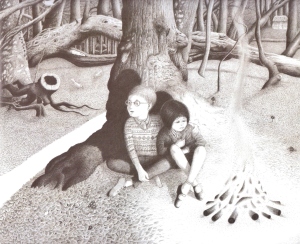
This book is interesting for two reasons:
1. It is the first book to win both The Carnegie Medal and The Greenaway Medal.
2. The author adapted a story originally thought up by another author; Siobhan Dowd.
Siobhan Dowd wrote in the young adult/teenage category of children’s literature. Her books ‘A Pure Swift Cry’ shortlisted for The Carnegie Medal in 2007, and ‘Bog Child’ which won the award in 2009 both deal with controversial, and social realist issues. ‘A Monster Calls’ is aimed a little younger than a typical Dowd book – which is fine: – Ness was not trying to be Dowd; he was writing her story in his own style. The result was a book which is deep, dark and intriguing.
Ness worked in his own style, on a story he adapted in his own way, and let it go in its own direction. Yet it still managed to capture the heart wrenching drama and tragedy of a Dowd book. Her books can touch teenagers and adults alike and this story is no different. Yes, the book is about a monster-tree. But this book about a monster-tree DOES deal with serious issues. This book about a monster-tree CAN be taken seriously by adults. Like any Dowd book, it deals with subjects that are hard to deal with:
Illness and death: “I can’t stand it anymore!.. I can’t stand knowing that she’ll go!”
Bullying: “Harry had tripped Conor coming into the school grounds… And so it had begun…and so it had continued.”
Feeling guilt: the need to be punished: “Why didn’t it kill me?.. I deserve the worst.”
Anger: “TEAR THE WHOLE THING DOWN!”
The book also contains three philosophical tales told by the monster-tree. Each of the three tales has a surprising moral to it. The conclusions about ethics, intentions, justice and punishment are debatable, and will make the reader stop and think.
The story is not only told with Ness’s words, but also with Jim Kay’s pictures. Each picture, scattered with minute detail is not only a superb piece in its own right, but also compliments and enhances the feel of the story. The illustrations are thicker and darker when Conor is feeling gloomy; light and minimalist when there is hope in his life. When Conor is feeling under pressure, the drawings engulf the pages and surround the words creating an almost claustrophobic atmosphere.
This is a thrilling yet moving read, full of twists and irony. The way the story is told is excellent. Children will be enthralled within its world of magic and fantasy, while adults will accept it as realistic and allegorical. The illustrations are dark and detailed; harsh yet elegant.
I wrote this for the library blog as part of Children’s Book Week (1st – 7th October 2012). The original blog post can be found here…
- A Monster Calls (lacer.wordpress.com)
- Patrick Ness – A Monster Calls (sffbookreview.wordpress.com)















